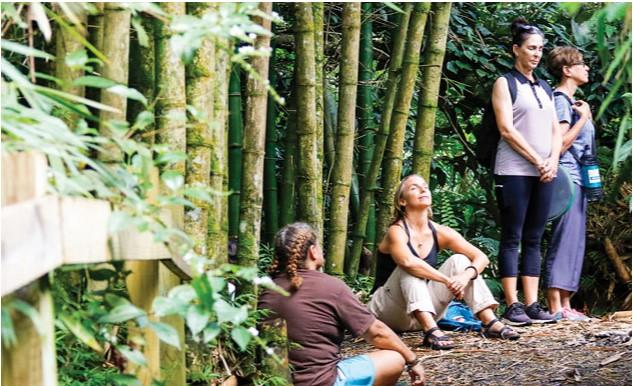
The forest is the therapist. The guide opens the door.
What if you could boost your well-being, improve your mood, lower your cortisol levels and keep your inflammation levels in check? What if these goals came not through diet, strenuous exercise or prescription medications, but rather by going for a walk in the woods?
In our fast-paced, technology-driven society, where digital connectivity is constant and quiet moments are hard to come by, choosing to unplug and spend time in nature can feel like swimming against the current. But this simple act, whether you consider it one of radical defiance or spiritual transcendence, can cure a multitude of mind-body ailments and requires no more than a
blue sky and the ground beneath your feet—and, in this case, a canopy of trees.
Forest bathing, also called forest therapy, derives from the decades-old Japanese practice of shinrin-yoku, which translates to “taking in the forest.” According to Dr. Qing Li, author of “Forest Bathing: How Trees Can Help You Find Health and Happiness,” “This is not exercise, hiking or jogging. It is simply being in nature, connecting with it through our senses of sight, hearing, taste, smell and touch. Shinrin-yoku is like a bridge. By opening our senses, it bridges the gap between us and the natural world.”
Unlike other outdoor activities, which are often done with a destination or goal in mind, forest therapy places no value on getting somewhere or accomplishing something. It is merely an invitation to cultivate deep relationships between humans and the more-than-human world.
The Association of Nature & Forest Therapy (ANFT) explains, “Forest therapy is not an extractive process, where we treat forests as a ‘resource’ from which we extract well-being for humans. Instead, it is a deeply relational practice, characterized by a sense of loving and tender connection. This connection leads naturally to an ethic of tenderness and reciprocity.”
Tamberly Conway—founder and CEO of Conservation Conexions, LLC, and an ANFT-Certified Guide—radiates the calm and tranquility one can expect to experience from shinrin-yoku.
“I’ve had some beautiful experiences in nature,” she says amid a chorus of birds that have taken up residence in a tree in the backyard of her Texas home, “but they (forest-bathing sessions) are a completely different experience. You start to notice things through your senses. They draw you in, and suddenly you’re not worried about what’s going to happen later today or tomorrow.”
Sessions, which are usually a mile or less and range in duration from 1 ½ to four hours, tout benefits for participants of all ages and fitness levels. While you can engage in forest bathing on your own, Conway suggests that you start out with a guide. “I would certainly tell someone to go out and bathe in nature—even going out to sit for 20 minutes. You might notice there’s a tree, but you don’t notice the intricacies of that being (a plant or tree species). We start to see what is happening in nature as it is happening in our lives.”
She views the experience as not only a powerful means of connecting with the natural world around us but also with others. “If you don’t push your edges, you’re never going to grow,” she offers.
“I’m hopeful that when they (participants) return to their homes, that their nearby nature will call to them, ‘Oh, come sit outside with me. Come sit and just be.’
To dive into the natural world that really holds you, there’s a shift that happens.” When asked about common misconceptions associated with the practice, Conway explains, “It’s not mindfulness. There are some kinships, but often people lump these into one bucket, and it’s very different because of the way people drop into their nature space. It’s very sensory-driven.”
To become a certified guide, Conway completed an intensive six-month training, which she described as “learning to guide people with your voice and into these invitations to allow themselves to just be.” One of the invitations she most enjoys—sessions will typically include several that participants are encouraged to share and reflect on with fellow group members—is to sit with a tree and ask it a question, whatever one emerges in the moment. Participants are often skeptical of the 20-minute invitations, but Conway says, “People completely lose track of time, and they forget about everything they have to do in their lives.”
She hopes that there will be more opportunities to bring the experience to sacred nature spaces, such as the Mt. Washington Arboretum, where she led a group at the conclusion of her practicum
in 2019, and to both underserved and urban communities where exposure to nature may be limited. She also envisions expanding offerings to hospitals, whose outdoor environments are designed to promote healing spaces.
Amid the hustle and bustle, the pings and pop-ups, make time each day to connect with the more-than-human world around you. Listen to the birds sing; place your hand on the rough bark of a tree or let it linger in the cool leaves. Take a deep breath and taste the freshness of the air as it enters your lungs. Allow your state of mind, your sixth sense, to be joyful and at ease. You don’t need an invitation or an agenda—only a willingness to commune with the environment around you and give back what you receive.
Additional Benefits of Forest Bathing
*Lowered blood pressure
*Increased activity of white blood cells, the body’s
natural killer cells
*Reduced depression, anxiety, fatigue and confusion
Forest Bathing Resources
Association of Nature & Forest Therapy Guides and Programs




